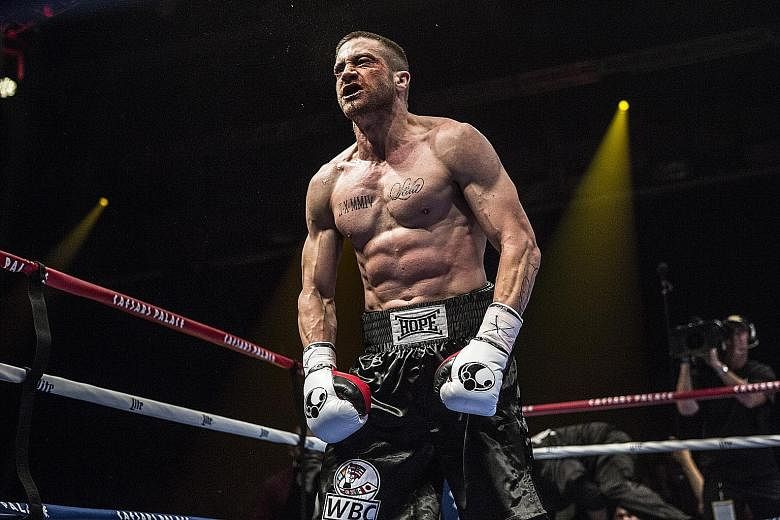Of all boxing's adored images - the drizzle of sweat, the leaking cut, the swell of the eye, the falling man - the camera also prizes a moment of peace: It is the fighter having his hands carefully taped. It is boxing's version of dressing up and it is hypnotic, a sort of orderly prelude to something crudely beautiful.
Thus Southpaw, the movie, begins. First day, Thursday, I am at the movie hall, a disciple of Gandhi but a fan of fighting flicks.
In a post-Tyson world of flaccid fighters, I get - like many of you - most of my boxing via movies. But I'd started young anyway, forced to listen to my father's generation imitate Marlon Brando, from On The Waterfront, drawling "I could've been a contender". In an Indian accent, it was not pretty.
Hollywood, happy to squeeze a tear out of any athletic story, knows the value of the sports film. They inspire (Chariots Of Fire), amuse (Cool Runnings), affect (Searching For Bobby Fischer) and infuriate (The Legend Of Bagger Vance). They can be small and splendid (Breaking Away) and large and pitiful (Days Of Thunder).
But boxing movies, with their unsentimental hitting wrapped in sentimental tales, are irresistible.
Just one list, on the movie database IMDb, produced 190 film titles with boxing threaded through them. Then last week I polled friends and family, of both sexes, in four countries, aged 29 to 58, to list their three favourite sports films and - but for one illiterate, now former pal - every person picked at least one boxing film.
Either The Fighter, Million Dollar Baby, The Hurricane or, of course, Rocky, which made Sylvester Stallone, meat lockers and mumbling, very popular.
Boxing's suffering has always beckoned a wide tribe. It has led novelists (Joyce Carol Oates, Norman Mailer) to write on it, singers (Bob Dylan) to protest about it and journalists to lose their moorings.
In a much-told story from 1923, journalist Paul Gallico stepped into the ring to spar with Jack Dempsey. He explained his editor wanted the story, to which the heavyweight champion replied: "What's the matter son, don't your editor like you no more?"
But it's film which embraces fighting tightest as if it's a science and an art made for each other. The camera adores boxing because there's something undressed to the sport. Its gyms are rarely shiny but worn, as if the walls have seen too much. Its sounds, of glove on flesh and heavy bags, are distinctive. Its training, skipping to music before greasy mirrors, is like a rough-hewn ballet. Its action is close, bloody, bare. Add a blonde, a fixer, a grizzled trainer, and off you go.
Fighters also seem to hail from another sporting church entirely, praying to a much rougher god. Tennis and golf films are usually appalling because they lack a rawness. Their characters are often middle-class chaps who probably carry nail cutters; boxing's men have hard times written on their faces.
They compete in a roped-off jail - easier to film - where victory offers them an escape from deprivation. James L. Braddock, played by Russell Crowe in Cinderella Man, took his chance and won the heavyweight title in a massive upset. Still, wrote The New York Times when he died: "If death came easily, it was the only thing in his life that did."
So many sports films, Seabiscuit for instance, walk down that old trail of second chances, but boxing possibly does it best. There's something earthy about men rising from the canvas towards redemption.
But through it all, the romance and corniness, the finest fight films own a grim heart, offering us scenes like Martin Scorsese's close-up shot of a rope in Raging Bull, blood slowly dripping from it. In boxing's torment, its human struggle, its physical cost, its bloody tension, lies an awful, dark splendour that other sports can't match.
Maybe actors, often found ringside at bouts, are drawn to this. Perhaps they see in boxing films a chance to inhabit a gritty, real world. To play a boxer they must passably become a boxer. They must wear split lips, sculpt bodies, polish technique. It gives them a certain authenticity but surely also a masculine swagger.
Daniel Day-Lewis got former world featherweight legend Barry McGuigan to train him for The Boxer while Denzel Washington was running about 10km, five days a week, for The Hurricane. Mark Wahlberg had a ring installed at home for The Fighter, though Robert De Niro, as usual, went just a little further than everyone. For Raging Bull, he trained so hard to play former boxer Jake La Motta that the real La Motta - so wrote Vanity Fair - quietly arranged three pro bouts for him.
Jake Gyllenhaal's body shows his homework but Southpaw bleeds unsatisfaction. But Hollywood is kind, we don't have to wait, for soon Miles Teller, from Whiplash, will be flicking jabs in Bleed For This. Apparently it is an inspirational tale, a line we might have heard before with boxing movies.
Anyway, as I left the hall after Southpaw, a thought wandered with me. I am not always sure if I approve of real boxing but the security of the boxing movie is that no one gets hurt, or left in a wheelchair, or loses his capacity to speak. The champions here, in fact, are people we never see.
The choreographer and the make-up artist.


